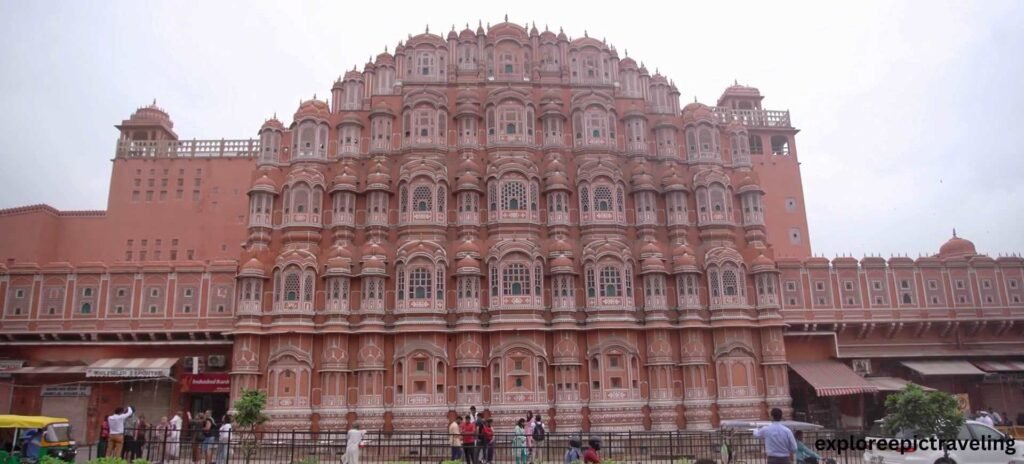
Absolutely, Hawa Mahal is definitely worth visiting! It’s an iconic landmark located in Jaipur, India, known for its unique architecture and historical significance. This five-story palace, constructed of pink sandstone, showcases elaborate designs and numerous windows, allowing refreshing winds to flow through and offering a beautiful view of the city.
So, if you have the opportunity, I highly recommend visiting Hawa Mahal to admire its beauty and explore its rich history.
Whenever you travel to any place ,first question came in our mind is that wheather is it safe place to visit means safety first comes in our mind before traveling.
So don't worry guys,when i am here.I will provide you a complete knowledge about the Hawa Mahal.
1. Is it safe to visit Hawa Mahal?
Here’s the information about Hawa Mahal safety, following the format you provided:
The Indian government implements several measures to ensure visitor safety at historical sites like Hawa Mahal:
Tourist Police: Rajasthan, the state where Hawa Mahal is located, has a dedicated Tourist Police force. These officers are trained to address tourist concerns and can be helpful in case of emergencies. They patrol tourist areas and historical sites, including Hawa Mahal.
Security Presence: Hawa Mahal, as a monument protected by the Archaeological Survey of India (ASI), has security personnel on-site. Their presence deters crime and ensures a sense of security for visitors.
Helpline: While there isn’t a specific helpline dedicated to Hawa Mahal itself, you can contact the Rajasthan Tourism Department helpline for any assistance you may need during your visit.
Here’s how to find the relevant helpline number:
- Rajasthan Tourism Department Helpline: You can contact the Rajasthan Tourism Department helpline at 1800 24×7 1177 (toll-free). This helpline can answer your questions or direct you to the appropriate resource for Hawa Mahal.
By being aware of your surroundings and these resources, you can increase your sense of security and have a more enjoyable visit to Hawa Mahal.
2. Lesser Known Facts about Hawa Mahal.
- Hawa Mahal in Jaipur was built in 1799 by Rajput Sawai Pratap Singh.
- Hawa Mahal is named after Hawa Mandir, a small temple placed inside the palace.
- Shaped like a Crown : Hawa Mahal is built in the shape of a crown, commonly, believed on Lord Krishna’s.
- Hawa Mahal literally means ‘Wind palace‘ or ‘The palace of winds‘, which comes from its 953 small windows.
- Hawa Mahal was built especially for Royal ladies to allow them to watch the day-to-day activities and festivities happening on the street without getting noticed by the public as they had to follow the stringent ‘purdah’ rule.
- No staircases: Though Hawa Mahal is a five-storey building, it is interesting to note that there are no stairs to climb. There are, however, only ramps that will let to reach the top floors.
- No front entrance: Hawa Mahal does not have a direct entrance; you will have to enter from the side of the City Palace.
- No interior courtyard: Surprisingly Hawa Mahal doesn’t have an interior courtyard, instead it has narrow passageways and chambers.
- It is interesting to note that the entire palace is laid without any solid foundation. And you know, Hawa Mahal is considered to be the tallest buildings in the world without any foundations, even though it isn’t as tall as compared to the skyscrapers of the world.
3. How to reach Hawa Mahal.
1.By Air:
- If you prefer air travel, Jaipur International Airport is the nearest airport to Hawa Mahal.
- It is located approximately 13 kilometers from the palace, the airport receives both domestic and international flights. From the airport, you can hire a taxi or take a pre-paid cab to reach Hawa Mahal within a short drive.
2.By Train:
- Jaipur Junction, the main railway station in Jaipur, is well-connected to major cities across India.
- It is located at a distance of approximately 6 kms from the palace.
- It takes around 20-30 minutes by taxi or auto-rickshaw.
3.By Road:
- Jaipur, being a major city in Rajasthan, is well-connected to neighbouring cities and states by a network of well-maintained roads.
- If you’re driving from Delhi, take NH48, also known as Delhi-Jaipur Expressway, which offers a smooth journey. The approximate distance from Delhi to Jaipur is around 280 kilometers, and the drive usually takes about 5-6 hours, depending on traffic conditions and the route you take.
- Parking facilities also available near Hawa Mahal. These parking areas are usually located within walking distance of the palace. However, parking availability and fees may vary depending on the time of day and the season.
4. Best time to visit Hawa Mahal.
The best time to visit Hawa Mahal Jaipur is in the morning when the sunlight makes a dash for all the windows of the palace, lighting it up like flickering flame on a candle.
If you really want to experience the magnificence of this monument, I will advise you to plan a holiday to Jaipur from October to March. During this time, the weather in Jaipur is pleasant, with temperatures ranging from comfortable to mildly warm, making it ideal for exploring outdoor attractions like Hawa Mahal.
5. Travel tips to Hawa Mahal.
1. Visit Early: To avoid large crowds and make the most of your experience, consider visiting Hawa Mahal early in the day when it opens. This allows for a more relaxed exploration.
2.Hawa Mahal is included in the list of places that you can visit with a “Tourist Composite Tickets“.
- Now, you have one question that what is tourist composite tickets?.
- Tourist Composite Tickets in Jaipur are passes that allow you entry to multiple popular tourist destinations at a discounted price compared to buying separate tickets for each place. They are a great way to save money and time, especially if you’re planning on visiting several attractions.
- Basically, you can get a composite ticket which gives you access to the following monuments in Jaipur:
- Amber Palace
- Jantar Mantar
- Hawa Mahal
- Nahargarh Fort
- Albert Hall
- Sisodia Garden
- Vidhyadhar Garden
How to purchase this Tourist Composite Tickets?
There are two ways from where you can purchase tickets are as follows:
- The ticket counters are usually located at the entrance of all the above attraction.
- Tourist Information Centers: Jaipur has several tourist information centers scattered throughout the city. These centers can also sell you composite tickets and provide information on which attractions are included in different ticket options.
- Validity period: These tickets are typically valid for two days from the date of purchase, allowing you to explore at your own pace.
Here’s a tip: It’s a good idea to check the official website of a particular attraction or the Rajasthan Tourism Department (https://www.tourism.rajasthan.gov.in/) for the latest information on ticket counters and availability of composite tickets.
3.Remember to dress modestly as a sign of respect for the cultural heritage and religious significance of the site.
4.Comfortable footwear is recommended as you will be exploring the multiple levels and architecture.
5.Don’t forget to carry sunscreen, a hat, and plenty of water, as the desert climate can be harsh.
6.Hiring a local guide can enhance your understanding of the history and architectural nuances of Hawa Mahal.
6. A Royal Tour: Inside the Hawa Mahal.
Most tourists visiting Jaipur feel that the Hawa Mahal is just a front. However, I would like to inform you that this palace has five floors, with numerous rooms built within. Let’s embark on a royal tour and discover these hidden gems:
1. Sharad Mandir

- Let’s start our royal tour on the first floor, called Sharad Mandir, meaning “Autumn Pavilion.” This floor was all about parties and festivals. Here, the royal ladies could watch the fun happening below from the big windows (jharokhas) that Hawa Mahal is famous for.
2. Ratan Mandir

- Let’s move up to the second floor, called Ratan Mandir, meaning “Gem Chamber.” This floor was probably used by the royal family for fun activities or gatherings. Its highlight is the stunning stained glass windows that sparkle in the sunlight, painting colorful patterns on the walls.
3. Vichitra Mandir

- Let’s head up to the third floor, called Vichitra Mandir, meaning “Enchanting Chamber.” This floor was a special place for the royal family. Here, Intricate jharokhas(balconies) provided a view of the busy city below. Most importantly, Vichitra Mandir was a place where the Maharaja worshipped Lord Krishna.
4. Prakash Mandir

- Let’s go up to the fourth floor, called Prakash Mandir, meaning “Hall of Light.” Here, you will see that, similar to the other parts of the palace, there are windows and jharokhas (balconies) built. This outdoor terrace offers amazing views of the city, allowing the royal family see all of Jaipur.
5. Hawa Mandir

- Let’s go up to the top floor, called Hawa Mandir, meaning “Hall of Winds.” This floor is the highlight of Hawa Mahal. This Hawa Mandir is built on the roof of the palace, and it receives very good airflow from all directions, acting like a natural AC, which is great in hot Rajasthan summers. In those times, the queens used to come to this place to enjoy fresh and cool air. From this roof, you can see the City Palace, Jantar Mantar.
7. Some other places inside Hawa Mahal.
1. Rare place

- Now, let me take you to a part of the palace that very few people visit. By going through this corridor, we will reach the next section of the palace. It is said that in those times, most tunnels had five paths, out of which only one was correct, and the other four were built to confuse the enemy. In a similar manner, you will see that there are five doors here, of which only this front door was used, and the other four doors were made to confuse the enemy.
2. Exhibition Hall
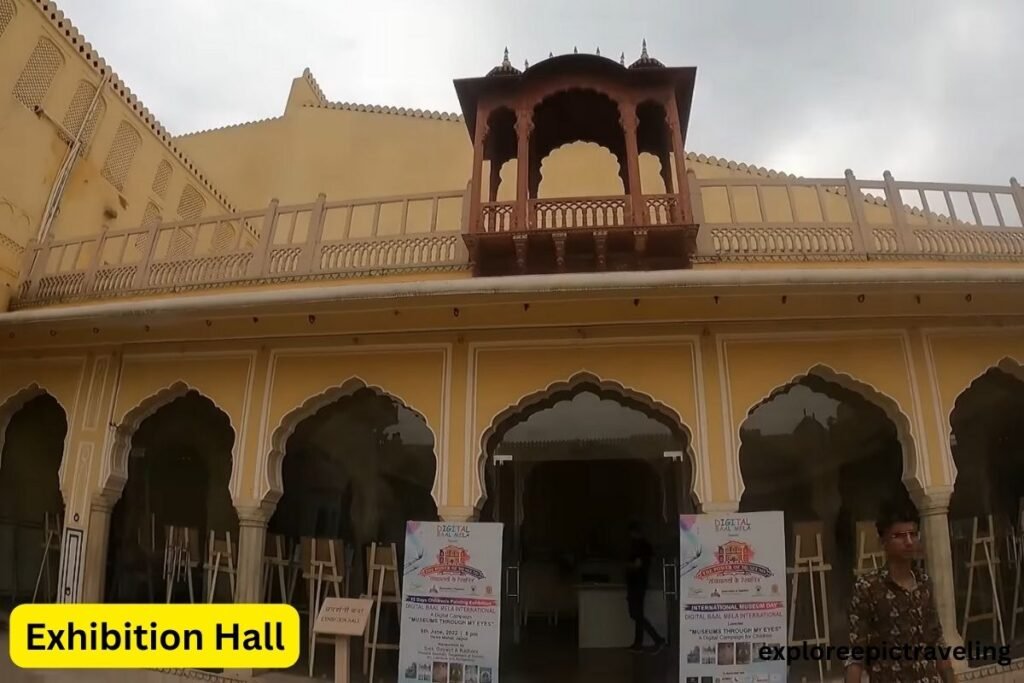
- Let’s head to an exhibition hall within Hawa Mahal, where you’ll find a collection of beautiful paintings on display.
3. Bhojanshala

- Now, we’ve arrived at the dining hall built within Hawa Mahal. In this very dining hall, the queens of that era used to sit on the ground and have their meals. You will see that this dining hall is also beautifully constructed.
8. Places to visit near Hawa Mahal.
There are several fascinating places to visit near Hawa Mahal, enriching your experience in Jaipur.
1. Govind Devji Temple
- Dedicated to Lord Krishna, this temple is located approximately 700 metres from Hawa Mahal and is crowded with thousands of devotees every day who gather for their Morning and Evening Aartis’.
- Their Laddoo’s are a must have, as suggested by many travellers and locals.
- There is no entry fee for the temple and is open for the public from 5:00 AM to 11:45 AM in the morning and from 5:00 PM to 8:45 PM in the evening.
2. City Palace of Jaipur

- Occupying almost one-seventh of the city of Jaipur, the City Palace is known for its vibrant layout and lovely craftsmanship that attracts many a traveller from distant places.
- It is located approximately 800 meters from Hawa Mahal.
- City Palace is open from 9:30 AM to 5:00 PM every day.
City Palce Entry Fee
- Indian Adult: Rs. 130 per person
- Indian Child: Rs. 70 per child
- Senior Citizen: Rs. 110 per person
- Foreign tourists: Rs. 500 per person
- Photography fee: Rs. 50
- Videography fee: Rs. 150
3. Jantar Mantar, Jaipur
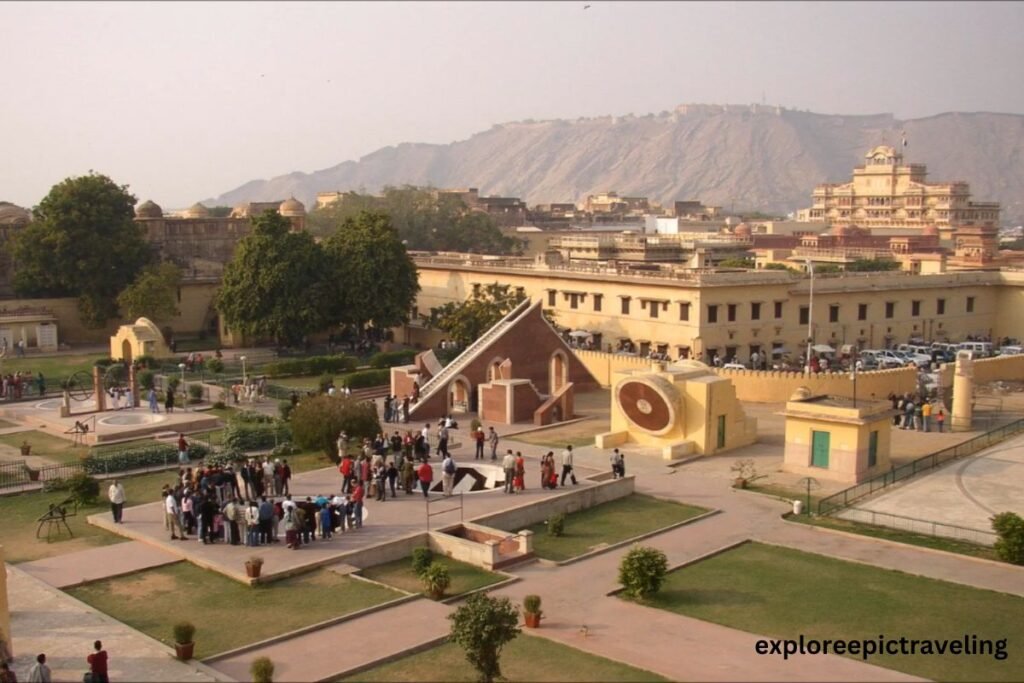
- Marked as a UNESCO World Heritage Site, Jantar is located very close to the City Palace. It is the largest of five astronomical observatories built by Maharaja Jai Singh II between the period 1727 to 1734.
- Hawa Mahal; it is just about 700 meters from the palace.
- Opening Timings of Jantar Mantar, Jaipur is from 9:00 AM to 5:00 PM every day.
Entry fee of Jantar Mantar, Jaipur
- Indians: Rs. 50 per person
- Students: Rs. 15 per student
- Foreign tourists: Rs. 200 per person
- Foreign students: Rs. 100 per student
4. Nahargarh Fort

- It’s resting on the Aravalli Hills, Nahargarh Fort offers amazing wide views of Jaipur’s skyline. Explore the fort’s intelligent architecture, visit its historical rooms, and take a relaxed walk through the lush(green) gardens. Capture lovely photographs of the cityscape from the fort’s view points.
- Timing: 10:00 am to 5:30 pm
- Entry Fee: ₹200 for adults, ₹50 for students
- Nahargarh Fort is approximately 6 kilometers (about 3.7 miles) from Hawa Mahal.
5. Jal Mahal
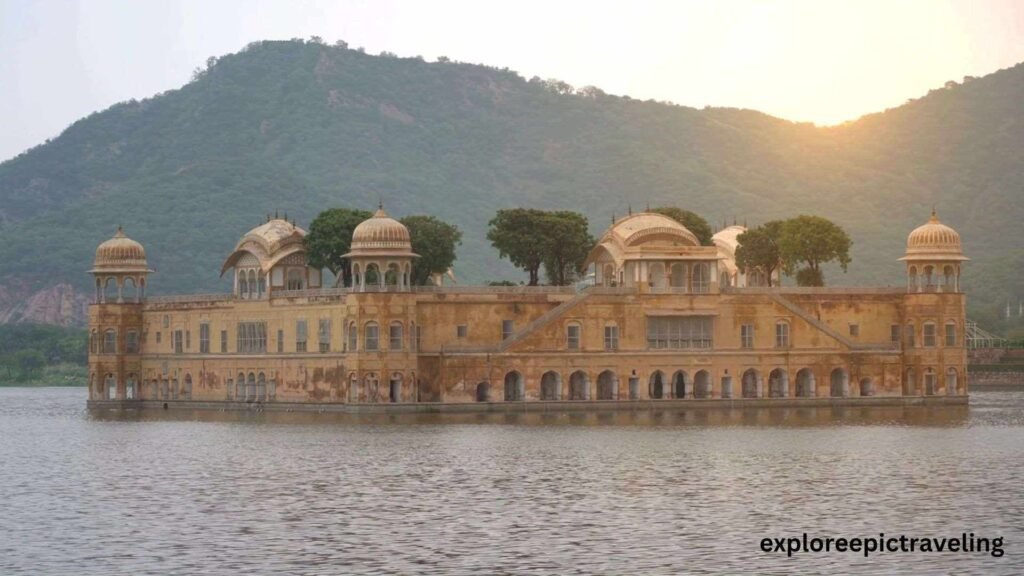
- Just a short drive from Hawa Mahal, Jal Mahal is a picturesque palace. It floats on the peaceful waters of Man Sagar Lake.Appreciate the beautiful Rajput and Mughal architectural elements of the palace and enjoy the peaceful atmosphere. Take a boat ride on the lake to get closer to this architectural phenomenon.
- Timing: Open all day for exterior view; boat rides available from 9:00 am to 5:00 pm
- Entry Fee: ₹50 for Indian nationals, ₹100 for foreigners (boat ride charges separate)
- Jal Mahal is approximately 6.5 kilometers (about 4 miles) from Hawa Mahal.
6. Albert Hall Museum

- Located within the stunning Ram Niwas Garden, Albert Hall Museum is a collection of art, objects, and historical items. Explore the vast collection of sculptures, paintings, textiles, and ancient objects that showcase the rich heritage of Rajasthan.
- Timing: 9:00 am to 5:00 pm
- Entry Fee: ₹150 for adults, ₹40 for students
- Albert Hall Museum is around 3 kilometers (about 1.9 miles) from Hawa Mahal.
7. Jaipur Wax Museum
- Explore your interest at the Jaipur Wax Museum. It is where realistic wax statues of renowned personalities from various fields displayed. Take photos with alongside celebrities, historical figures, and cultural icons, creating unforgettable memories.
- Timing: 10:00 am to 6:30 pm
- Entry Fee: ₹300 for adults, ₹200 for children
- Jaipur Wax Museum approximately 6 kilometers (about 3.7 miles) from Hawa Mahal.
8. Galta Ji Temple

- Immerse yourself in spirituality and peacefulness at Galta Ji Temple, also known as the Monkey Temple.In the hills, this temple complex is a peaceful place to visit. You’ll also see playful monkeys there.Explore the temples, enjoy the peaceful atmosphere, and see the evening aarti (prayer ceremony).
- Timing: 5:00 am to 9:00 pm (Varies for specific temple rituals)
- Entry Fee: No entry fee, but donations are appreciated
- It is located about 8 kilometers (about 5 miles) from Hawa Mahal.
9. Hawa Mahal Jaipur Timings.
| Day | Timing |
|---|---|
| Monday | 9:00 am – 5:00 pm |
| Tuesday | 9:00 am – 5:00 pm |
| Wedesday | 9:00 am – 5:00 pm |
| Thursday | 9:00 am – 5:00 pm |
| Friday | 9:00 am – 5:00 pm |
| Saturday | 9:00 am – 5:00 pm |
| Sunday | 9:00 am – 5:00 pm |
Hawa Mahal is open every day from 9:00 AM to 5:00 PM.The museum is closed on Friday and Saturday.
10. Entry Ticket Fee of Hawa Mahal.
- Indians: Rs. 10 ($0.60 USD) per person
- Foreigners: Rs. 50 ($2.60 USD) per person
Note: The Palace is not accessible to people in wheelchairs.
11. Places to Stay near Hawa Mahal.
Here are some recommended accommodations near Hawa Mahal, Jaipur:
| Accommodation Name | Distance from Hawa Mahal | Description | Price Range (Approx.) |
|---|---|---|---|
| LMB Hotel | 0.6 km | Well-known hotel offering comfortable rooms and a famous sweet shop. | ₹2,500 – ₹4,000 |
| Virasat Mahal Heritage | 0.8 km | Heritage hotel with traditional Rajasthani architecture and decor. | ₹3,000 – ₹6,000 |
| Jaipur Hotel New | 1.0 km | Heritage hotel with a terrace and close proximity to major attractions. | ₹3,000 – ₹5,000 |
| Hotel Arya Niwas | 2.3 km | Eco-friendly hotel with gardens and a well-reviewed restaurant. | ₹2,000 – ₹4,000 |
| Alsisar Haveli | 2.5 km | Heritage hotel offering traditional decor with modern amenities. | ₹5,000 – ₹8,000 |
| Hotel Diggi Palace | 3.1 km | Luxury heritage hotel with beautiful gardens and a historic setting. | ₹4,000 – ₹7,000 |
| Hotel Ram Singh Palace | 3.5 km | Budget-friendly hotel with clean rooms and essential amenities. | ₹800 – ₹1,500 |
| Hotel Pearl Palace | 3.8 km | Boutique hotel known for its unique decor and Peacock Rooftop Restaurant. | ₹1,000 – ₹2,500 |
These accommodations offer a variety of options for visitors, from budget-friendly stays to luxurious heritage hotels, all within a convenient distance from Hawa Mahal.
12. FAQs about Hawa Mahal.
Q1.How much time is enough for Hawa Mahal?
Ans: The amount of time you spend at Hawa Mahal can vary depending on your interests and how much you want to explore. About 1-2 hours is enough because there isn’t much to see beyond the outer appearance.
Q2.What is the Speciality of Hawa Mahal?
Ans: Hawa Mahal has following specialities as follows:
- Built without a foundation, it’s a beautiful mix of different building styles.
- The Hawa Mahal is famous for its 953 tiny windows.
- Every floor of Hawa Mahal has a temple.
Q3.Can we visit Hawa Mahal at night?
Ans: No, you cannot visit the inside of Hawa Mahal at night. The monument closes around 4:30 pm.
Q4.On which day Hawa Mahal is closed?
Ans: Hawa Mahal is not closed on any day and it is open to visitors every day of the week, including weekends and public holidays.
Q5.Are there no stairs in Hawa Mahal?
Ans: Yes, that’s right! Hawa Mahal is known for having no stairs. Instead, it uses gentle ramps to travel between its five floors.
Q6.Why does Hawa Mahal have windows?
Ans: Hawa Mahal has numerous windows, known as “jharokhas,” for ventilation and to allow the flow of air through the building.This is why Hawa Mahal is called the “Palace of Winds.”Additionally, the jharokhas served a practical purpose for the royal women who resided within, allowing them to observe the street life and festivities without being seen from the outside.
Q7.What is the top floor of Hawa Mahal?
Ans: The top floor of Hawa Mahal consists of small chambers and balconies, offering a panoramic view of the city. The top floor of Hawa Mahal is called the Hawa Mandir.
Q8.What is the name of the third floor of Hawa Mahal?
Ans: The third floor of Hawa Mahal is called the Vichitra Mandir. It was a private space used by the Maharaja for prayer and relaxation.
Q9.What is the height of the Hawa Mahal?
Ans: The Hawa Mahal stands at a height of about 50 feet (15 meters).

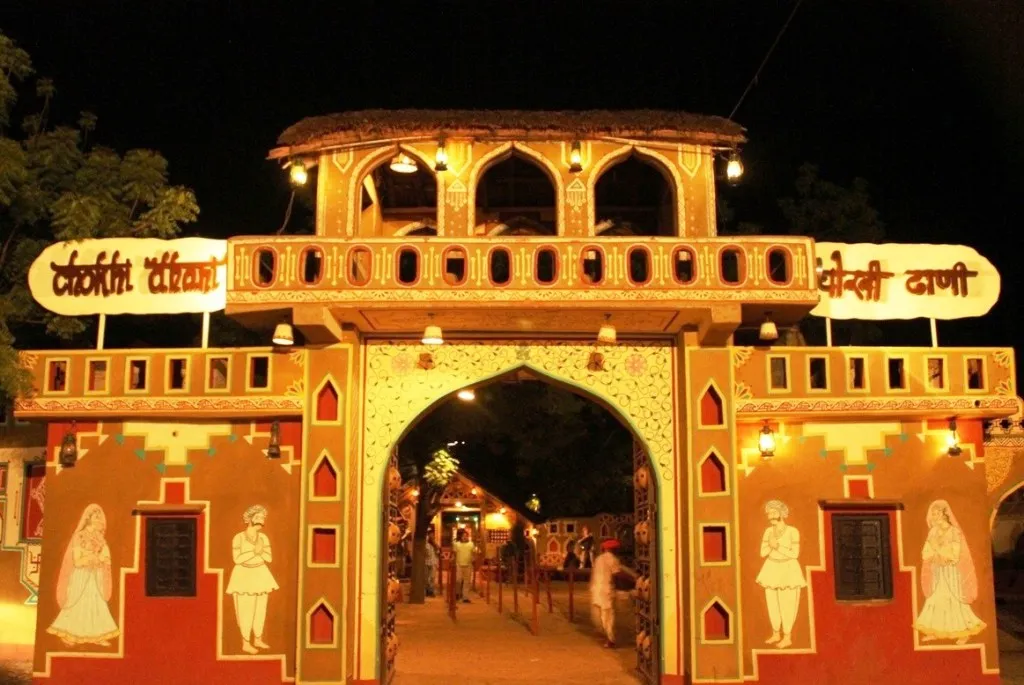

Your means off telling tthe whole thing in this post is in fact good, all be capable of without difficulty understand it, Thanks
a lot. https://www.waste-ndc.pro/community/profile/tressa79906983/